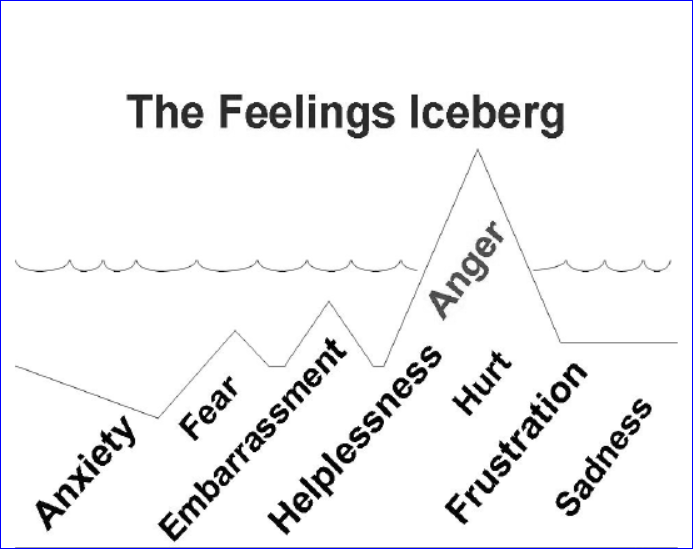Getting to The Bottom of Feelings for Effective Confrontations
There are two kinds of people in this world: those who think the world can be divided up into two kinds of people, and those who don’t.
Likewise, there are a lot of people out there who will be happy to tell you there are really only two emotions: Love and Fear. This theory of basic emotions, which seems to have originated with pioneering grief psychologist Elisabeth Kübler-Ross, has insinuated itself so deeply into the popular imagination it even played a significant role in the plot and theme of the cult Jake Gyllenhaal  film, Donnie Darko.
film, Donnie Darko.
More recently, the Pixar film Inside Out posited room for a few more basic emotions: a total of five (Anger, Fear, Sadness, Joy, and Disgust.) And in 2014, researchers at the University of Glasgow, searching for an empirical basis for the most basic human emotional building blocks, used facial expressions to try to narrow down our primal emotional spectrum to just four basic emotions: happy, sad, afraid/surprised, and angry/disgusted.
The Importance of Identifying Feelings Accurately in I-Messages
Why are theories of basic emotion important for leaders?
Because there are three components of an effective Confrontive I-Message—one that’s intended to influence another person to consider changing behavior to help a leader meet his or her needs.
- A non-blameful description of the behavior that’s in the leader’s area of unacceptance, causing a problem for the leader
- A statement about the tangible, concrete effects the behavior is having on the leader
- A description of the feelings the leader has in response to the effects of the behavior
Feelings, in the Gordon Model, are genuinely something we feel. Physically. They’re centered somewhere in the body: That sick, uncomfortable dread that bubbles up in the stomach when you’re feeling anxious; a rush of blood to the head when you’re feeling threatened; shaking and a racing heartbeat associated with a rush of adrenaline in a fraught situation; tense muscles and shoulders like boulders the night before a really important presentation before the board. They’re not abstract—they’re physical, and they signal a deep emotion.
Too often, reductively, and with a false sense of simplicity, it may be tempting as a leader to leap to “I’m angry” as the third part of a Confrontive I-Message. But anger is one of those basic emotions that can overlay, obscure, and obstruct other, more complex, more refined and more honest emotions that are lurk beneath the surface. Those more genuine emotions are the ones that the person being confronted will find more motivating than “I’m angry.” (Hearing “I’m angry” from somebody with the power to hire and fire is generally received as a threat, which means it’s not part of a constructive I-Message).
As an example, I’d like to bring up something that happens to me very rarely—but it does happen.
Is it Road Rage—or Something Else?
Ride with me.
I’m in my tiny little convertible Miata, sitting in rush hour traffic, waiting at a red light to get on the Southern California freeway, which itself is moving at the NASCAR-approved speed of 10-15 MPH, and we’re stacked ten cars deep. There are three lanes of traffic trying to merge onto a six-lane freeway. Two cars are allowed to move onto the freeway per green light, per lane.
Have I mentioned my car is tiny? I can’t see above or around other cars. I can barely see the car in front of me (because I’m generally surrounded by SUVs and trucks, but even when I’m not, full-sized cars are larger than I am and have higher vantage points). I have to judge whether there are one or two cars in front of me based on how long I believe them to be, whether I believe the first car at the light took a creeping head start of four or five feet past the stop line, and so on. Sometimes, I get it wrong. And when I get it wrong, I err on the side of caution. (The fines for being the third car through a two-car light are not insignificant.)
Meanwhile, behind me, there are sometimes…impatient other drivers. Equipped with horns. And fingers. Attached to arms. Which are flailing at me. Occasionally there are voices shouting out of windows.
When other drivers use these items to let me know they don’t approve of my decision to not risk it and sit at the light through one more cycle, I get ANGRY.
But am I really just…angry?
First of all, I’m frustrated. Because we’re all sitting in the same traffic, and none of us are going anywhere fast. Had I tailgated the SUV ahead of me through the light, hoping I was the second (and not the third) vehicle, sure. The BMW behind me would have been first through the light next time. But we’d still be stuck driving at a speed my dog can out-trot for the foreseeable future. Secondly, I’m feeling anxiety and fear. Road rage is a thing. A very real thing. Some people carry guns in their cars. Some people use them. In situations that begin with simple misunderstandings, miscalculations, and oversights. Thirdly, I’m embarrassed. Yes, I really do wish sometimes that I had X-Ray vision and could better see through or around the vehicles in front of me, so I didn’t annoy those behind. Genuinely. But I can’t deliver a mea culpa to the now-dozen cars behind me, nor can I do anything to make up for the fact that I misjudged how many cars had gone before me. I’m stuck at the light for another cycle. I’m helpless.
Admitting all of those deeper emotions requires admitting a deeper level of vulnerability than simply saying “I’m angry!” and using my own horn and fingers and flailing arms and escalating the situation.
But it’s an exercise in examining deeper emotions that can go a long way toward teasing apart the non-basic emotions beyond “anger.”
The next time you’re angry (or shortly thereafter, if you need to take some time to breathe deeply and take a walk to get some distance from the physical feelings associated with anger), do a bit of self-assessment and see whether you can identify any of the deeper emotions that anger may have been disguising. The exercise will go a long way toward helping you formulate more effective, genuine, honest, and productive third parts of your I-Messages.


